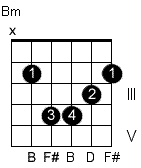You can use a capo to easily change the key of a song. A lot of people do this so that they can sing the song in a range that is comfortable. Regardless of where you place a capo, the idea is that you create a ‘floating nut’.

In other words this part of the guitar is no longer relevant because the capo takes place of the nut. The nut could be considered the outermost point that a string can sound. In other words it limits the absolute fretting ability.
When a capo is placed on the 3rd fret of the guitar, the first two frets are no longer relevant to the guitar. Instead, the capo on the 3rd fret has become the nut so to speak. That being said, all you have to do is basically ‘pretend’ that the capo becomes the outermost and absolute point that a chord can be fingered from. In the case of Bm, if we used this version….

That would mean that the notes fretted are (high E string is on top):
E ——–2——–
B ——–3——–
G ——–4——–
D ——–4——–
A ——–2——–
E ——–x——–
However, if we added the capo on the 3rd fret, while the fingerings remain the same, if you counted from the ORIGINAL nut, or in other words, pretended that the capo wasn’t there, it would actually look like this (again from the original nut of the guitar):
E ——–5——–
B ——–6——–
G ——–7——–
D ——–7——–
A ——–5——–
E ——–x——–
What you’ve really done is displace, or ‘transpose’ the orginal key of the song and created the same Bm chord finger arrangement, except you’ve applied it to the fretboard as if the nut (which is actually the capo when applied) was the 3rd fret instead. Check this out:

Here we have the G chord being played with the capo on the 3rd fret. As you can see, it’s still the G chord, but instead it has been adjusted to what the capo provides as the ‘new’ nut of the guitar. (I’m using the G because it is easier to understand.)
No matter which chord you use, the same fingerings for the frets will still need to be applied.

The chart above might seem terrifying, but really it isn’t.
We’re using the capo on the 3rd fret, so that means the notes at fret “zero” are now:
open —> 3rd fret capo
E —— = G
B —— = D
G —— = A#/Bb
D —— = F
A —— = C
E —— = G
With the capo applied to the 3rd fret, and if you were going to play a G chord, you’ll need to finger the notes that make up the G chord, which are:
3rd fret capo
G—————– = A#/Bb (3rd fret on High E string after capo)
D—————– = F (3rd fret on B string after capo)
A#/Bb———– = A#/Bb (no fretted notes)
F—————– = F (no fretted notes)
C—————– = D (2nd fret on A string after capo)
G—————– = A#/Bb (3rd fret on Low E string after capo)
The key has now changed to A#/Bb instead of G due to the capo being placed on the third fret. While that may seem confusing, all you REALLY need to know is that you must adjust the chords being fretted when using a capo. Basically pretend that the capo has become the nut of the guitar, and you’ll have no worries.